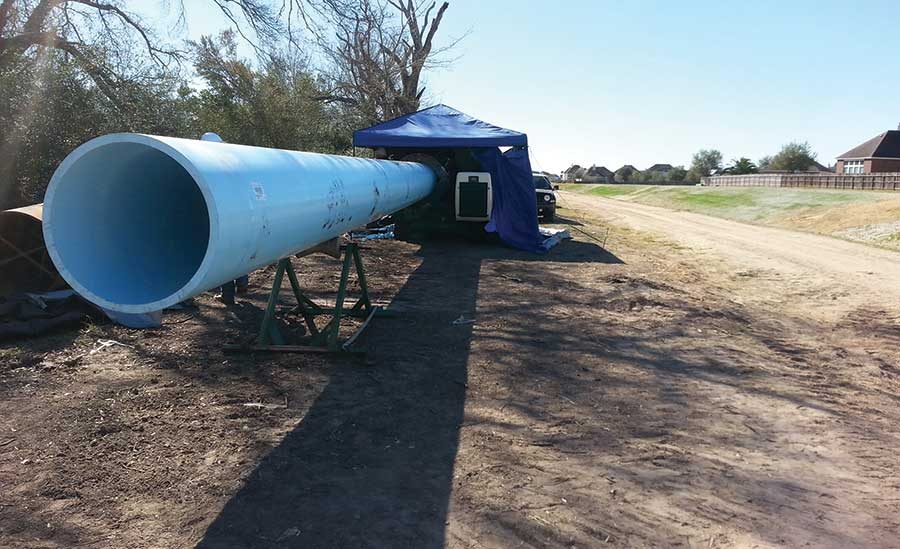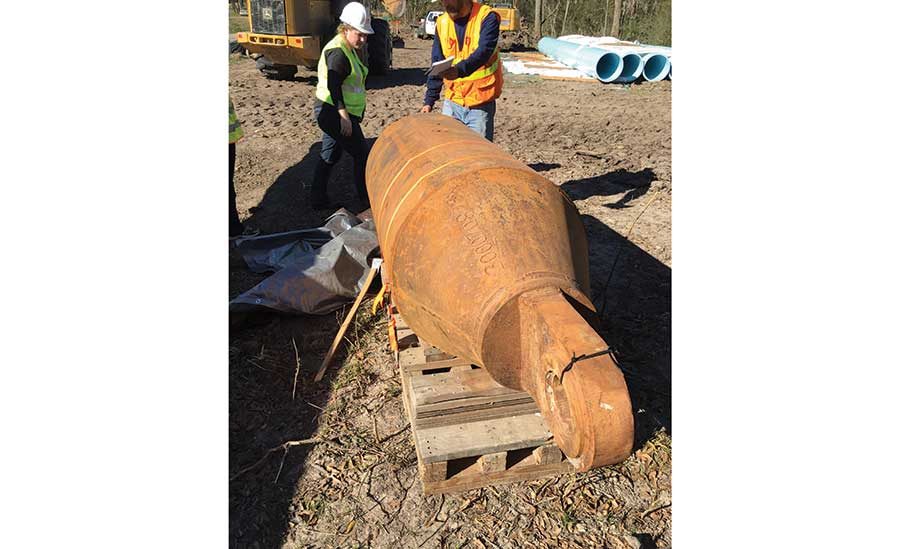To address a growing population and increasing potable water demand, the West Harris County Regional Water Authority (WHCRWA) was created in 2001. The main goal of the authority, which covers approximately 226 square miles and 460,000 people in and around Houston, is to reduce groundwater use by converting to surface water.
Article Index:
- Drilling Under Wetland
- Rain and Runaround
- Making Room for 2,200 Feet of Pipe
- Choosing the Right Equipment
So far, more than 51 miles of new water transmission mains have been built in an effort to ensure that, no later than 2035, 80 percent of total water demand is provided by surface water. An important part of that construction initiative is Contract 34, which involves the installation of approximately 18,700 linear feet, around 3.5 miles, of 30/24-inch potable water lines from north of Cypress North Houston Road to Harris County MUD 371/374 Water plant.
While the majority of Contract 34 was achieved through traditional trenching methods, crossing a portion of the Cypress Creek watershed, a protected wetland area in eastern Texas, recently called for horizontal directional drilling (HDD). The Woodlands, Texas-based Meiners Construction Inc., a heavy civil construction company, served as the general contractor for the project. TCH Directional Drilling, an HDD drilling company headquartered in Friendswood, Texas, was subcontracted by Meiners Construction to install approximately 2,200 linear feet of pipeline underneath Cypress Creek by way of HDD. Lockwood, Andrews & Newman Inc. of Houston served as the engineer of record.
Drilling Under Wetland
Initially, the plan to cross Cypress Creek called for conventional tunneling, which would have been inside a casing, explains Christine Kirby, P.E., standards engineer with Lockwood, Andrews & Newman, and part of the design team for the HDD Cypress Creek crossing. After a study delineated the extent of the wetland, the length of the crossing increased substantially and HDD was recommended as the best installation method.
In early February 2016, a crew of 12 from TCH Directional Drilling — two superintendents, four equipment operators and six helpers — started drilling at the Cypress, Texas, site. Using an American Auger DD-440T directional drilling rig with a 10-inch tricone bit, a PowerFlow mud cleaning system and a Vector Magnetics ParaTrack steering tool for guidance, the team completed a 2,200-foot-long borehole about 40 feet below the surface and installed 30-inch DR 21 Fusible PVC pipe inside. While the rest of the project — mainly built through trenching, but with a few cases of tunneling — used concrete pipe materials, Fusible PVC was selected for the HDD portion because of its ability to handle the bending radius and because of its greater inside diameter due to smaller wall thickness than HDPE.
Once the rig and equipment were set up at the entry location on one side of Cypress Creek, the drill bit entered the ground, reached 40 feet deep, drilled a flat tangent and then, on a 2,000-foot radius, made an upward curve to exit the ground on the other side of the wetland, explains Colby Ellis, operations manager at TCH Directional Drilling.
Upon reaching the exit location, the bit was removed and the reaming process started. To keep the solids manageable, the crew did not start with making the hole size they ultimately intended to create. Using drilling fluid to help carry the cuttings out, Ellis says they completed the hole in small increments. First they cut about a 24-inch path, then about 36-inch, and finally between 44- and 48-inch, he says. Each step was the same: they pulled the reamer back from the exit location to the rig while pulling drill stem behind it to eliminate the possibility of a cave-in.
Once the final diameter was achieved, drilling fluid and cuttings were left behind, Ellis says. To make sure there were no problem spots left in the borehole, the crew ran what they call a swab pass, involving a large, smooth reamer with caps on each end that looks like a barrel. As it was pulled, drilling fluid was pumped through the hole to flush out the solids. Once the reamer arrived back at the rig, it was taken to the exit point one more time and placed back onto the drill stem that trailed behind it. A swivel, which was connected to the 2,200 feet of pipe lying on rollers, was attached to the reamer. As the drill stem and reamer pulled pipe into the hole the swivel prevented any torsional stress on the pipe. The drillers also had to deal with buoyancy control, which called for filling the line with water as they pulled it to prevent the pipe from floating too much and rubbing against the top of the hole on its way back to the rig.
Approximately 1,500 feet of the total length of the borehole was drilled flat and encountered mostly sand. On the way down and then back up, however, the geology was made up of numerous changing face conditions, including layers of sand and lean clay. The HDD aspect of Contract 34 was successfully completed on March 3, 2016.
“We’re happy. We could have probably ended a few days earlier had weather cooperated, but all in all there were no major issues I’m aware of on our end,” Ellis says.
Rain and Runaround
Both ends of the jobsite were about a mile off-road, which was not much of an issue in dry conditions, Ellis says. However, wet ground conditions caused by rain made movement between the entry point and exit point of the borehole challenging.
During the early stages of the HDD process, while the borehole was being drilled, there wasn’t much of a need for crew members to leave the site where the rig was located. But when the hole was finished and the reaming started, all of the drilling fluid and cuttings came out at the exit side, across the wetland from the rig.
“So even though we were only 2,200 feet apart as a crow flies, it was more like a three- or four-mile drive — we moved the mud around in tanker trucks — to get it from the exit location around to where the rig was. It took some time,” Ellis says.
With so much rain, Ellis says the HDD crew easily lost five days, even working six days a week. With muddy ground conditions added to the already timely runaround between sites, large tanker trucks hauling fluids and cuttings were slowed due to sinking into the unstable ground.
Making Room for 2,200 Feet of Pipe
Aside from the transportation issues that were exacerbated by rain, Ellis says no other notable challenges presented themselves. An important part of avoiding setbacks was careful planning, which Kirby was heavily involved in.
Open trenching was done all the way up to the point where horizontal drilling started, but the easement trenching crews were using was not sufficient for the TCH Directional Drilling team.
“The open-cut portion of the project was built in a 20-foot wide easement with an adjacent 15-foot wide temporary construction easement. The area needed for the drill pad would be much larger,” Kirby says. “Adequate space is essential.”
During the design phase, Kirby determined that the size of the drill pad on the entry side would need to be 80 feet wide and 100 feet long at minimum to accommodate equipment. This included the vacuum truck, drilling rig, track hoe and 18-wheeler trailer with drill stem and mud system. Obtaining a temporary construction easement was crucial to making sure drillers had enough room, Kirby says.
On the other side of the wetland, the layout of 2,200 feet of pipe string had to be carefully planned. Since the pipe was fused as drilling took place, it had to be laid out linearly with the borehole so that it could be pulled in toward the entry point where the rig was. This meant Kirby had to make sure there would be enough space lengthwise to string the pipe together without obstructing anything, like intersections for example.
Choosing the Right Equipment
Just as HDD is different from open trenching, it is different from vertically drilling. One of the biggest differences is the importance of pulling the pipeline in, Ellis says. If the pullback is unsuccessful, all of the actual drilling of the borehole goes to waste.
“You can have a hole down there and if your pipe can’t make it through the hole for some reason, you can’t get paid, it’s not usable by anybody,” he says.
Another big difference Ellis points out is dealing with drilling fluids.
“We try to keep circulation the same way that people that drill vertically do. But it’s a lot harder because we don’t have gravity working for us. It’s actually working against us, whereas if you’re drilling straight down, it’s natural for the fluid pressure to pump the mud and cuttings back up the hole along the drill string.”
He explains that a big issue with HDD is the loss of circulation and fracking out, where the mud travels to the point of least resistance, which often is up to the surface. When drilling across wetlands like Cypress Creek, to frack out is a big deal. He says HDD is more complex than vertical drilling in that way because keeping circulation and drilling fluids where you want them is not as easy.
Getting through obstacles like this with minimal trouble, whether drilling for municipal water lines or private oil pipelines, is all dependent on equipment. For Contract 34, Ellis says his crew used top-of-the-line tools and they made for a smooth operation.
He points out that every drilling rig and mud system is not right for every job. When his company comes across a request for proposal outlining a job that is too big for the equipment they have, they simply do not bid it.
“Don’t bring a knife to a gun fight. Show up with the right equipment and use the equipment right and have good people working with you and things will probably go pretty well, the way that you planned. … I think that’s the main thing.”









Report Abusive Comment